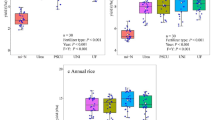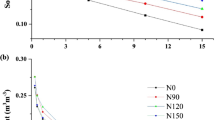Abstract
Azolla and urea application in a rice field transplanted with square (20 cm×20 cm) and rectangular (10 cm×40 cm) spacings for three consecutive seasons were found to increase significantly uptake of N and P by the rice plants, irrespective of seasons. Azolla treatments increased the organic C content of the soil during both wet and dry seasons, while its N and P contents were more only during the wet seasons. Urea did not affect N, P and organic C contents of the soil. Spacing had no significant effect on N and P uptake by the rice plant or N, P and C contents of the soil.
Maximum N and P uptake in rice were obtained by growing two crops of Azolla after transplanting in addition to its incorporation before transplanting. This treatment showed significantly more N uptake than the urea at 60 kg N ha−1 during wet and dry seasons of 1982. Among Azolla treatments, twice Azolla dual cropping although showed comparatively lower uptake of N and P, it was comparable to that of 60 kg N ha−1 urea.
Similar content being viewed by others
References
Anonymous 1975 Cultivation, propagation and utilization of Azolla. Chekiang Agricultural Academy, Institute of Soils and Fertilizers.
Craswell E T and Vlek P L G 1982 Nitrogen management for submerged rice soils. 12th Intl. Congress Soil Sci. Trans., New Delhi, India, pp 158–180.
Jackson M L 1967 Soil Chemical Analysis. Prentice Hall of India, New Delhi.
Koyama T and App A 1979 Nitrogen balance in flooded rice soil.In Nitrogen and Rice. pp 95–103. Intl. Rice Res. Inst., Los Banos, Laguna, Philippines.
Koyama T, Chamruk C and Niamsrichand N 1973 Nitrogen application technology for tropical rice as determined by field experiment using N15 tracer techniques. Tropical Agricultural Res. Cent. Tokyo, Japan Tech. Bull. 3, 1–79.
Patrick Jr W H and Mahapatra I C 1968 Transformation and availability to rice of nitrogen and phosphorus in waterlogged soils. Adv. Agron. 29, 329–359.
Ponnamperuma F M 1972 The chemistry of submerged soils. Adv. Agron. 24, 29–96.
Prasad R and Thomas J 1982 Nitrogen.In Review of Soil Researches in India. Trans. of 12th Intl. Congress of Soil Sci., New Delhi, India.
Shiga H and Ventura W 1976 Nitrogen supplying ability of paddy soil under field conditions in the Philippines. Soil Sci. Plant Nutr. 22, 387–399.
Singh P K 1982 Azolla as an organic nitrogen fertilizer for medium and lowland rice.In Review of Soil Research in India. Part I pp 236–242. Trans. 12th Intl. Congress of Soil Sci., New Delhi, India.
Singh P K, Panigrahi B C and Satapathy K B 1981 Comparative efficiency of Azolla, BGA and other organic manures in relation to N and P availability in a flooded rice soil. Plant and Soil 62, 35–44.
Watanabe I, Bai K Z, Berja M S, Espinas C R, Ito D and Subudhi B P R 1981 The Azolla-Anabaena complex and its use in rice culture. IRPS 69, 1–11.
Yoshida S, Forno D A and Cock J H 1977 Laboratory Manual for Physiological Studies of Rice. p 71. Intl. Rice Res. Inst., Los Banos, Philippines.
Author information
Authors and Affiliations
Rights and permissions
About this article
Cite this article
Singh, A.L., Singh, P.K. Influence of Azolla management on the growth, yield of rice and soil fertility. Plant Soil 102, 49–54 (1987). https://doi.org/10.1007/BF02370899
Received:
Revised:
Issue Date:
DOI: https://doi.org/10.1007/BF02370899




